“We didn’t have another band to point to and say, well, Sabbath is using it or the Scorpions are using it. James had the foresight to say, ‘Let’s try it. Maybe we’re the people to embrace it’”: James Hetfield’s tech shows you his 72 Seasons live rig
Chad Zaemisch has been the Metallica leader’s right-hand man for 20 years. He discusses the metal titans’ amp modeling sea change, why his boss “chickened out” with his new 72 Seasons ESP Vulture, and what happens when things go very, very wrong onstage…
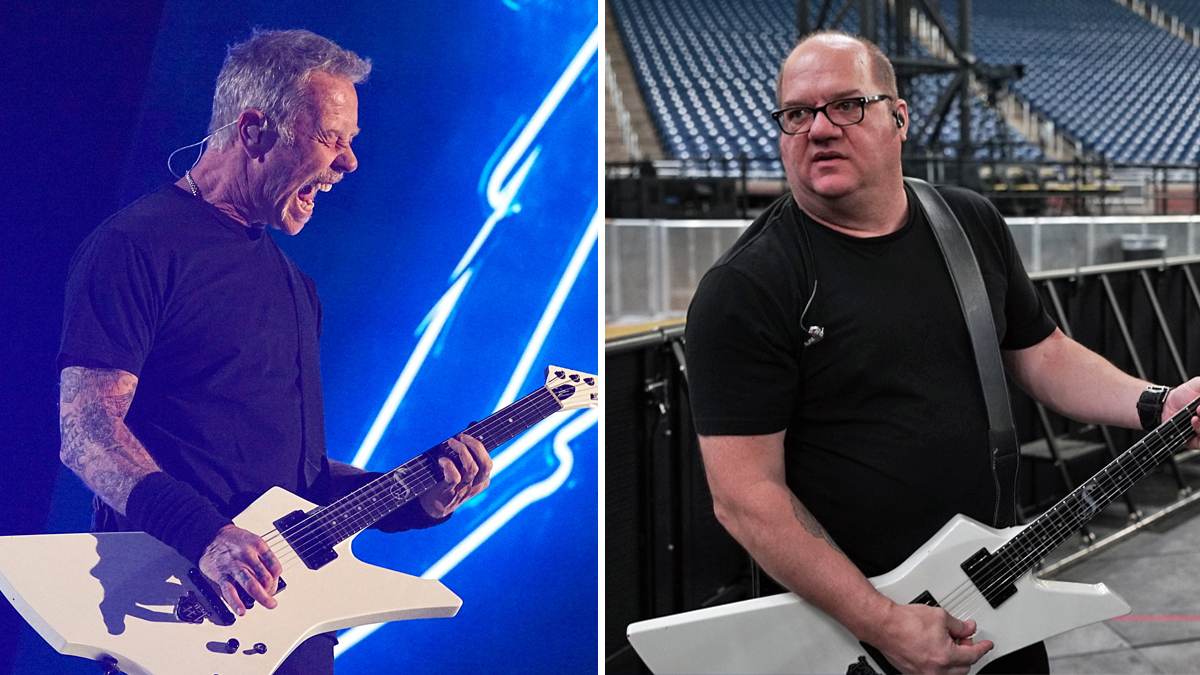
“It feels like the last week of school; nobody wants any tests, nobody wants any drama,” says Chad Zaemisch, the guitar tech for James Hetfield. Guitar World was able to catch Zaemisch at Metallica’s last show of 2023 on their two-year 72 Seasons World Tour, before the band and the crew take a deserved six-month break from a grinding schedule.
While Metallica has taken a step back from the grueling tour itineraries that earned them their reputation as a formidable live band, they haven’t lost sight of the experience of a Metallica concert. Which means that the entire production is a fulltime job for the band and the crew.
“We can't come in in a day and set this whole thing up like we used to. We started all this on Monday. There’s a lot more coordination, a lot more production. These large towers [are] the most laborious thing,” says Zaemisch.
The towers, which stretch from the floor to the ceiling and house the PA and video screens, need to be set up before crew like Zaemisch can even come into the arena. “When there’s room, we can kind of start creeping in here. The band or Lars might come and start rehearsing on Wednesday.”
On the 72 Seasons tour, Metallica are performing in the round, on a stage that is 120 feet in diameter. For crew members like Chad Zaemisch, this means that his office at Ford Field is in front of 60,000 people.
“We’re not really doing this like normal, and that’s sort of the Metallica way. It's almost like a metaphor for the online experience these days, where you can't say or do anything without it being under a microscope,” says Zaemisch.
There is an immense weight on the shoulders of techs in a band like Metallica. In addition to fans recording concerts on their phones, Metallica also records each concert to be sold as CD or download through their website. “We try to do the best we can every night. Nothing is like, ‘Oh, that was yesterday. We don't worry about that.’”
Get The Pick Newsletter
All the latest guitar news, interviews, lessons, reviews, deals and more, direct to your inbox!

2023 marks Zaemisch’s 20th year with the band, and you don’t keep your job in one of the biggest bands in the world without trying to be better than you were yesterday.
“I would always work on an amp sound in the tuning the band uses, which is D#. You kind of have to focus on that low note,” says Zaemisch.
But when he would hand Hetfield a guitar like the purple Snakebyte, the baritone used for songs on St. Anger, Zaemisch noticed issues with the way that their analog gear responded to the low tunings. “Especially with James, the sound has to be chunky, but the bass frequencies can’t hang over too far because he’s such a percussive player.”
For many years, navigating the variables and limitations of analog gear came with the territory of being the guitar tech for the biggest heavy metal band in the world. But when the band were asked to play Carlini Base in Antarctica, they were faced with one major challenge: in order to protect the arctic wildlife, the stacks of heads and cabinets – essential to Metallica’s ferocity – were not welcome on the trip.
Enter: Axe-Fx, Fractal Audio Systems’ top-of-the-line amp modeling rig. With this system, the band was able to wirelessly transmit the sound of their guitars directly into the headphones of the 120 audience members inside a dome constructed on Carlini Base for the concert.
“We did our best to duplicate the sound of the analog rigs [in Antarctica],” says Zaemisch. The results were better than many expected. “One of the very first things I noticed when we plugged into the Axe-Fx was that I could focus the EQ down in the right area for the low chunk and it still translates to a guitar that’s been tuned lower.”
This opened up several doors for Metallica’s live sound. “All of a sudden, these things that the band might only be able to do in the recording studio were now possible outside of the recording studio,” says Zaemisch. “An analog amp responds differently to something that is tuned down, whereas the Axe-Fx can take whatever that information is and deal with it a lot better. It’s insane.
“Before, I needed two huge racks. I needed a main head and a spare head. Since James relies on two amp sounds, I needed another rack that had the other stuff, the other heads, like the Diezel heads that we used to use. I had another small rack that had the clean sound and the [Roland] JC-120 head. It was so much equipment.”
When the band left all that analog gear behind for the Freeze ‘em All show in Antarctica, not only did they quickly see advantages in the stability and consistency of their sound with the Axe-Fx, but they were also happy with the economical advantages that the compact systems offer.
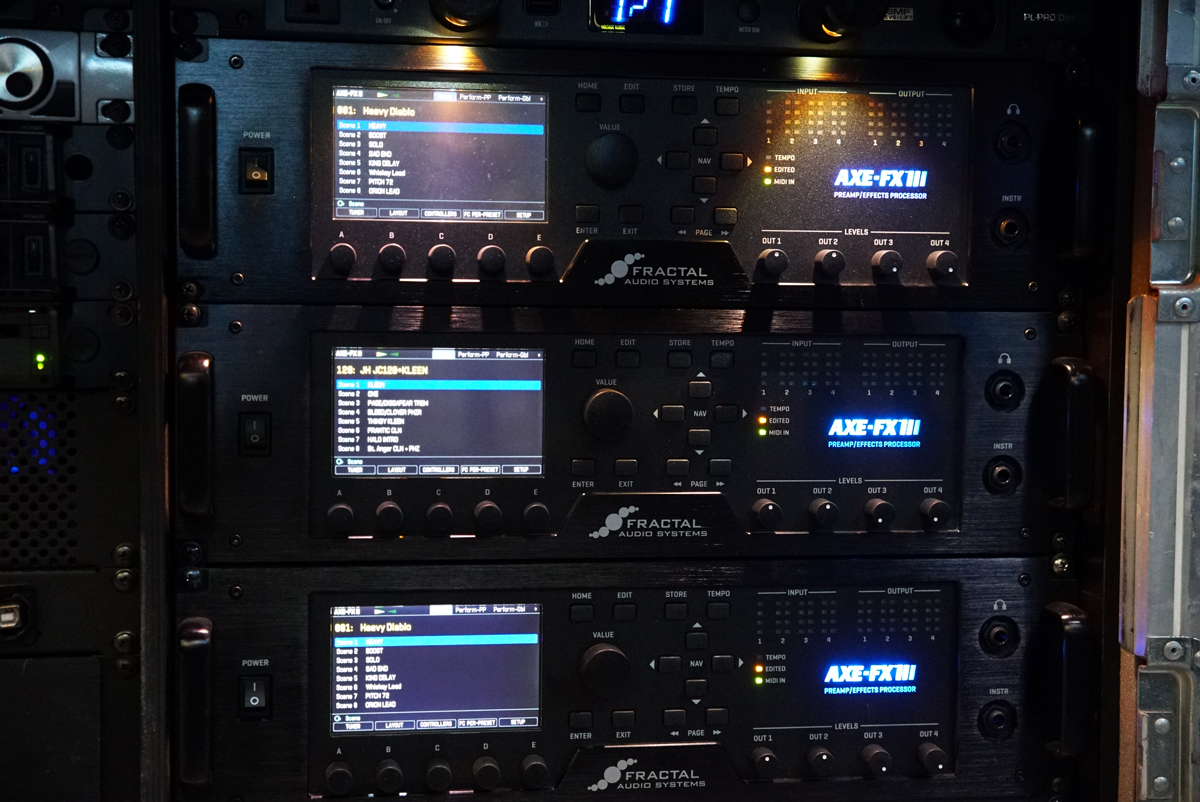

“The first time that we sent them overseas, they paid for themselves,” Zaemisch reveals.
While the advantages of transitioning the band’s live rig from analog to digital were clear, it was understandably met with a bit of apprehension. “After Antarctica, we were faced with [questions],” admits Zaemisch. “Are we going to go in another direction, with the Axe-Fx, or are we going to go back to the way things were?”
“We didn’t really have another band to point to and say, well, Sabbath is using it, or the Scorpions are using it. I have to hand it to James. He had the foresight to say, ‘Let’s try it. Maybe we’re the people to embrace it.’ It’s been a cool journey.”
Like anybody else, James wants to stand in front of cabinets and feel his pants shake
But the bedrock of heavy metal is a wall of Marshall stacks so loud that they rattle the pictures on your neighbors’ walls. So in order to make sure the band can still feel the music, Zaemisch and the Metallica crew push the guitars out to eight Meyer monitors on the stage.
“Like anybody else, James wants to stand in front of cabinets and feel his pants shake,” says Zaemisch. “There’s [eight] hotspots on the stage, four for James and four for Kirk. The hotspots have 12-inch cones in them, and the normal vocal monitors have 10-inch cones in them. We like the bigger ones just for a little bit more chunk. If James wants a little sustain or wants some feedback, he knows to go to a hotspot. I mean, no guitar player wants to go without being able to do that, right?”
“We needed to kind of be able to hear what it would sound like as a 4x12 but also through the PA because that's ultimately where it was going to go. [So,] we took a pair of these Meyer monitors, plugged them straight into the output of the Axe-Fx, and got all our sounds that way,” he explains.
As much as Hetfield himself was spearheading the adaptation of these futuristic amp modeling systems, he has had no such approach to his guitars. His new book, aptly titled Messengers: The Guitars of James Hetfield, essentially serves as Hetfield’s memoir, wherein he shares the story and personal significance of his most treasured guitars. Many of the guitars featured in the book come with Hetfield on the road.
“I have ‘Carl’ out here with me,” says Zaemisch. “Carl,” featured in Messengers, is a guitar by Ken Lawrence that is made out of the wood from the garage where Metallica wrote and arranged both Ride the Lightning and Master of Puppets. “It’s cool, and it has a lot of history, but it’s a heavy guitar, weight-wise. So it wasn’t a favorite to play.”
When you prowl as much as Hetfield does on stage, it makes sense to choose a guitar that’s on the lighter side. Hetfield’s White Snakebyte guitar, the “OG Snakebyte,” is a favorite of Zaemisch’s for that reason.
“The White Snakebyte, I can kind of slip it in on songs that I would traditionally use more of a Les Paul-shaped guitar,” says Zaemisch. “It fits in with a bunch of different eras [of Metallica].”
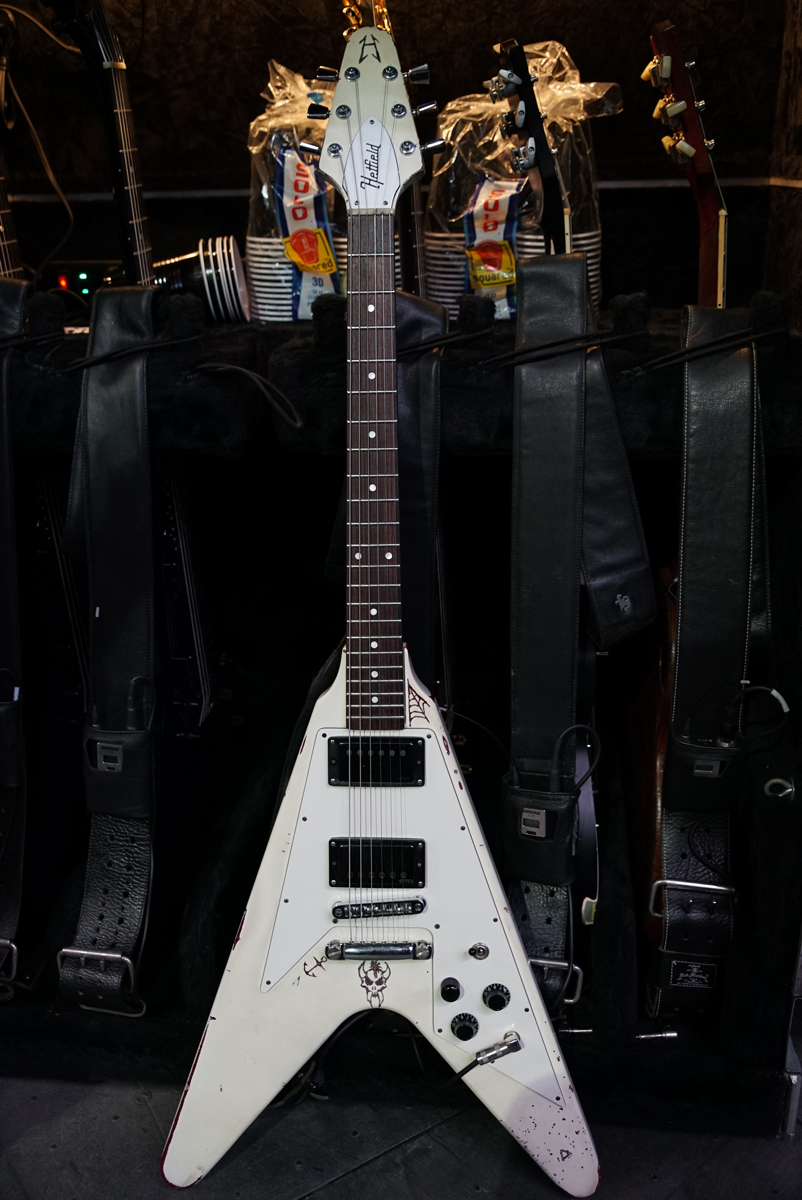


There is a lot of collaboration between Zaemisch and Hetfield in terms of which guitars the frontman will play throughout the live show.
“Over the years, I know the vibe he kind of wants,” says Zaemisch. For example, the band has been opening their concerts on the M72 World Tour with three “old-school” songs to begin the set. For those songs, Zaemisch will hand James the “New Electra” guitar, a copy of the white Electra V that Hetfield bought in the band’s infancy.
“That V was surprising. I was afraid [at first]. I was like ‘Oh no! It’s a 70s copy?! I gotta make this thing work?’ Lo and behold, it holds a tune really well. It’s my only bolt-on neck. Fortunately from Gary Brawer [guitar repair based in the Bay Area] having it and the original construction from the Japanese plant, they actually made some pretty good guitars.”
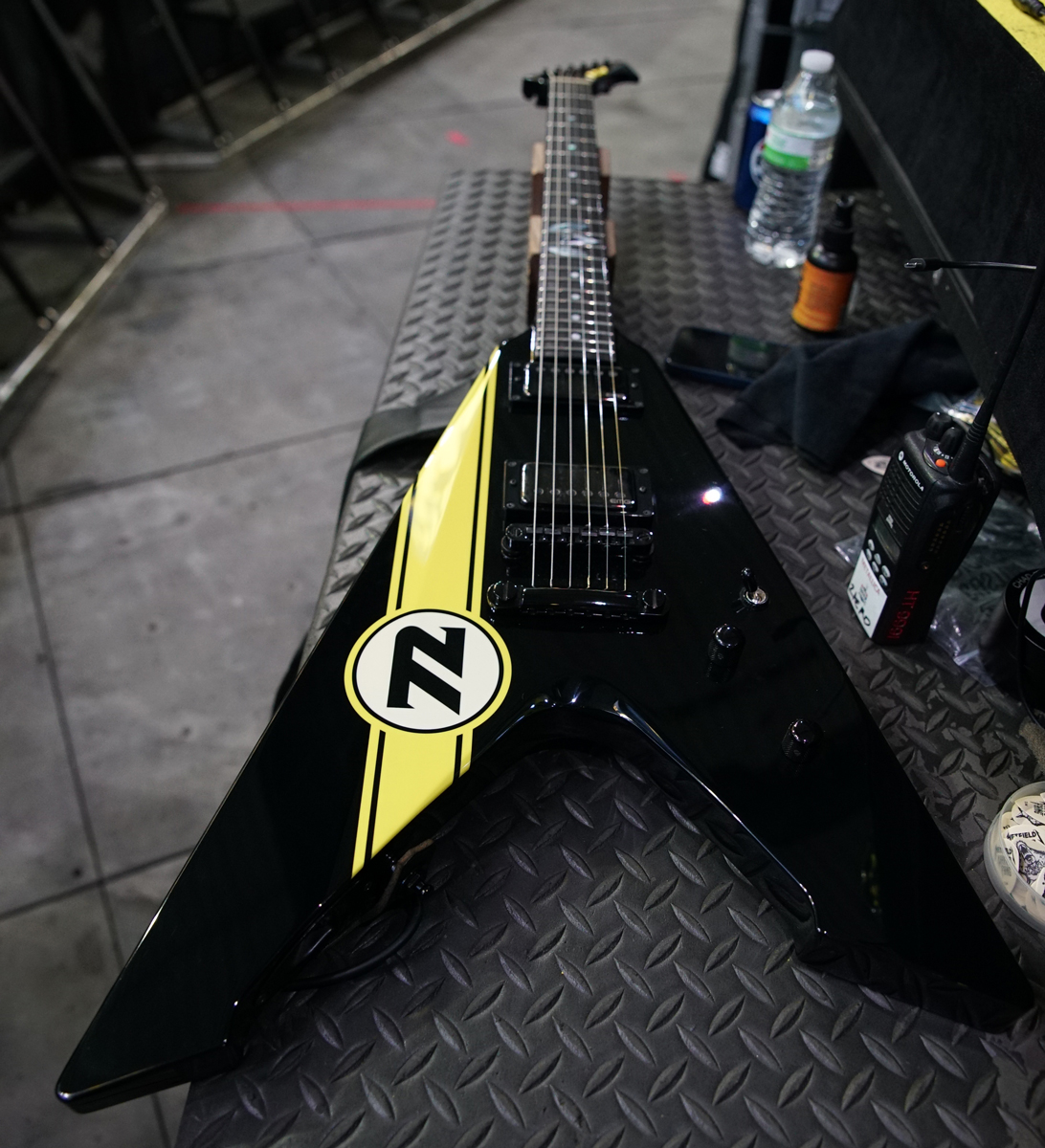

For the new songs, Zaemisch will hand Hetfield the new 72 Seasons ESP Vulture. Hetfield has had a relationship with ESP Guitars since he met Matt Masciandaro at the NAMM show in 1987. With every new album, it seems that ESP is more than happy to help Hetfield out with a new guitar.
“We’ve got to have one new, shiny guitar, right?” Zaemisch laughs. “James got together with Matt Masciandaro and mocked up a couple of things with their art department. Up until the last minute, this guitar was going to be a bright yellow, [but] James kind of chickened out and decided to do it black and make the stripe yellow.”
One of the more unusual guitars Zaemisch will hand Hetfield is a Line 6 Variax 700, used for The Unforgiven and Fade to Black. Named Unforgiven, after the jaw-dropping pyrography by Dino Muradian, this guitar is, by definition, an electric guitar.
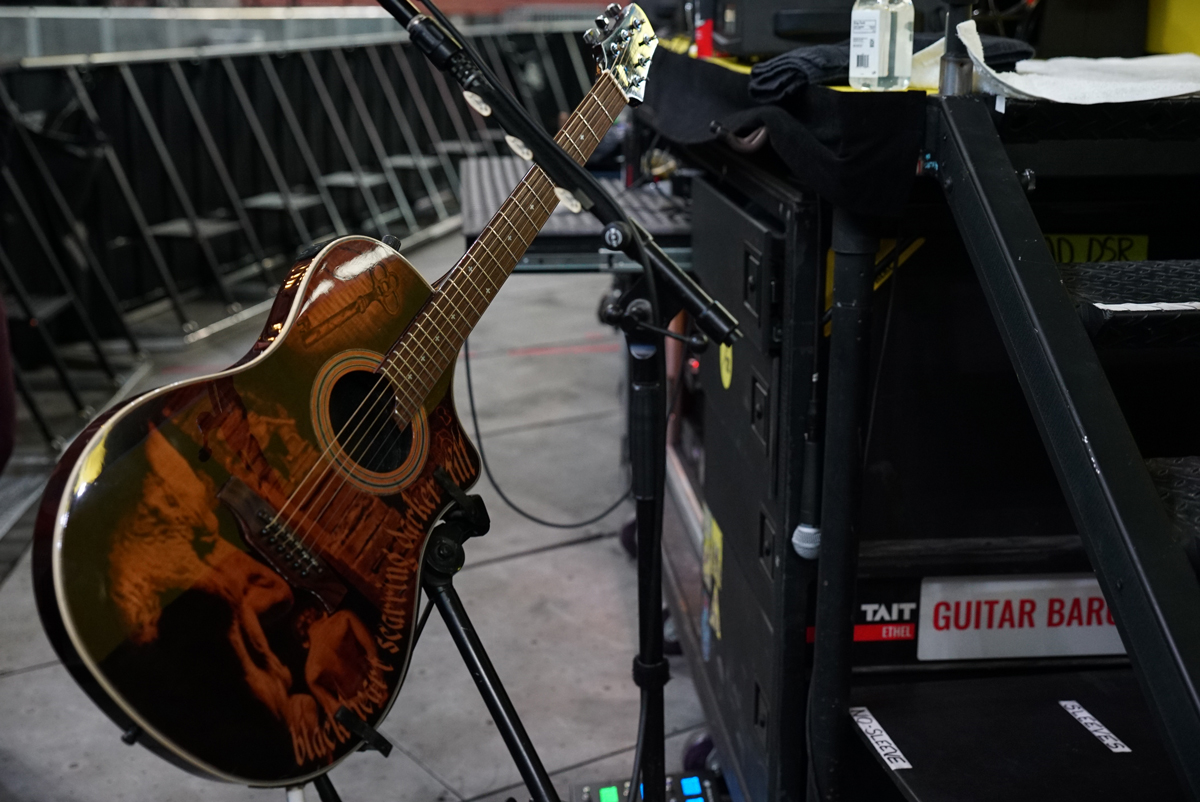

The preamp modeling inside the guitar – by Antares – allows the guitar to sound like a traditional acoustic without the feedback issues that arise from mic’ing up a hollow guitar in an arena.
That modeling inside the guitar was born out of necessity. “There was one company that had a wireless MIDI system that let me down a few times,” says Zaemisch. One of the times he is referring to, of course, is when the preamp modeling failed and the guitar wasn’t tuned properly for Fade to Black.
“I’m sure you can find the video online. Our normal tuning is D#, and there’s one video [online] where the program change didn’t make it to the guitar, so it was stuck in E. When the intro tape started, it was a half-step up. James lost it and kicked the guitar over.”
Of course, this sent all the armchair quarterbacks in the YouTube comments into a frenzy. “‘Well, dude, you had one job to do!’” laughs Zaemisch. “You can’t explain to somebody in two sentences why [the guitar] wasn’t correct,” he shrugs.
Not wanting something like that to happen again, Zaemisch started looking into other technologies that would be more reliable. Through trial and error, he realized that he would have to carve his own path, so he started his own wireless technology company, Lite-Time.
“[During the pandemic,] I just sat down and started learning as much as I could. You have to be able to tell yourself that you’re gonna make mistakes, and that’s okay. I retrofitted some of Rob’s expression pedals with my wireless stuff,” says Zaemisch.
It’s likely that mindset is what has helped Zaemisch keep his job as James Hetfield’s right-hand man for nearly 20 years. That, and the trust Hetfield has in Zaemisch.
“Once in a while, [I’ll hand him a guitar] and he’ll be like ‘This one??’ [and I’ll say] ‘Yeah. It’s gotta be that one,’” he laughs. “He trusts me. He doesn’t really want to think about that stuff.”
- Messengers: The Guitars of James Hetfield is available now from Amazon and Metallica.com. The M72 tour continues through 2024 – see Metallica.com for full dates.
“It was tour, tour, tour. I had this moment where I was like, ‘What do I even want out of music?’”: Yvette Young’s fretboard wizardry was a wake-up call for modern guitar playing – but with her latest pivot, she’s making music to help emo kids go to sleep
“There are people who think it makes a big difference to the sound. Stevie always sounded the same whether it was rosewood or maple”: Jimmie Vaughan says your fretboard choice doesn’t matter – and SRV is his proof








![John Mayer and Bob Weir [left] of Dead & Company photographed against a grey background. Mayer wears a blue overshirt and has his signature Silver Sky on his shoulder. Weir wears grey and a bolo tie.](https://cdn.mos.cms.futurecdn.net/C6niSAybzVCHoYcpJ8ZZgE.jpg)

![A black-and-white action shot of Sergeant Thunderhoof perform live: [from left] Mark Sayer, Dan Flitcroft, Jim Camp and Josh Gallop](https://cdn.mos.cms.futurecdn.net/am3UhJbsxAE239XRRZ8zC8.jpg)
